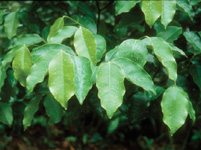

Chips of the incense-containing dark heartwood of aloeswood placed on the lighter sapwood. Material courtesy Robert E. Blanchette.
“ALOE” IN THE BIBLE SUFFERS FROM a serious case of mistaken identity. Many might think that the aloe plant, Aloe vera (Agavaceae), used in lotions, shampoos, and other common medicaments, is the aloe mentioned in the Bible. But “aloe” is a completely different plant. Aloe vera is a shrubby plant. The juice of A. vera has no distinctive fragrance (Miller 1969).
Aquilaria malaccensis, on the other hand, is a tree that is found in tropical lowland forests in Southeast Asia (Baruah et al. 1982, Pojanagaroon and Kaewrak 2005). The heartwood of the agarwood tree, also known as aloeswood in English, is the source of an expensive, highly valued fragrance. In fact, the tree is in such demand that programs for planting trees to avoid cutting older trees in the forest are being developed in several South Asian countries.
The oil is distilled from the heartwood of the tree. Unlike many other woody plants with aromatic compounds, agarwood cannot be tapped or the material collected by incisions in the bark; the tree trunk must be destroyed to prepare the incense (Langenheim 2003). The wood is sold either as chips or splinters or as the derived oil.
How did agarwood become “aloe”? Greppin (1988) suggests that because Bible translators were not acquainted with true aloeswood, they simply translated the Hebrew and Greek words as aloe, a linguistically related plant name. This is of special interest, since Dioscorides notes that the aloe used by the Greeks came from India and that its source was a tree, indicating that its source might have been Aquilaria (Greppin 1988, Schoff 1922). Avicenna (Ibn Sina) (Welborn 1932) recommended it as a medicine.

Tree in Bhutan, where aloeswood trees are planted for commerce to avoid further damage to native populations. Courtesy Robert E. Blanchette.

Leaves of aloeswood, Bhutan. Courtesy Robert E. Blanchette.
In the Old Testament, the Hebrew word for the aloeswood plant is ahaloth. The Hebrew word suggests “sticks of wood,” which would correspond with the way aloeswood is sold today. It is translated in the KJV both as “aloes” (Psalm 45:8; Proverbs 7:17; Song of Solomon 4:14) and, most accurately as lign (tree) aloe in Numbers 24:6: “As the valleys are they spread forth, as gardens by the river’s side, as the trees of lign aloes which the LORD hath planted, and as cedar trees beside the waters.”
The Numbers reference is intriguing because it is part of Balaam’s curse-turned-blessing on the Children of Israel, which took place in the Jordan Valley. Balaam was a native of Mesopotamia, his home not far from the ancient major city of Carchemish. Was his familiarity with this plant, its uses, and habit a result of the use of aloeswood in that region? Aloeswood was widely traded in ancient times (Miller 1969). Cedar of Lebanon, which did not grow in Mesopotamia, is mentioned in this verse, suggesting that both aloeswood and cedar were used as symbols for beauty.
The Greek word aloay, used only in John 19:39 (NJB), probably refers to the incense: “Nicodemus came as well—the same one who had first come to Jesus at night-time—and he brought a mixture of myrrh and aloes, weighing about a hundred pounds.”
Despite repeated references in the literature (Baruah et al. 1982, Pojanagaron and Kaewrak 2005), I have found no evidence that aloeswood was used by the ancient Egyptians.